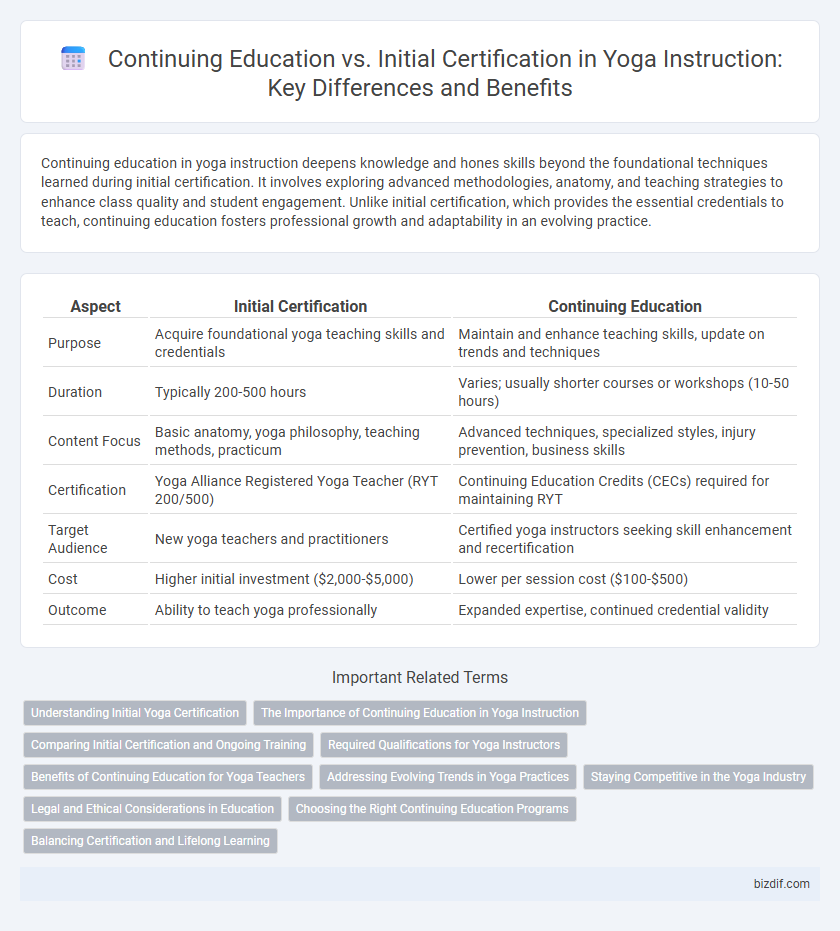Continuing education in yoga instruction deepens knowledge and hones skills beyond the foundational techniques learned during initial certification. It involves exploring advanced methodologies, anatomy, and teaching strategies to enhance class quality and student engagement. Unlike initial certification, which provides the essential credentials to teach, continuing education fosters professional growth and adaptability in an evolving practice.
Table of Comparison
| Aspect | Initial Certification | Continuing Education |
|---|---|---|
| Purpose | Acquire foundational yoga teaching skills and credentials | Maintain and enhance teaching skills, update on trends and techniques |
| Duration | Typically 200-500 hours | Varies; usually shorter courses or workshops (10-50 hours) |
| Content Focus | Basic anatomy, yoga philosophy, teaching methods, practicum | Advanced techniques, specialized styles, injury prevention, business skills |
| Certification | Yoga Alliance Registered Yoga Teacher (RYT 200/500) | Continuing Education Credits (CECs) required for maintaining RYT |
| Target Audience | New yoga teachers and practitioners | Certified yoga instructors seeking skill enhancement and recertification |
| Cost | Higher initial investment ($2,000-$5,000) | Lower per session cost ($100-$500) |
| Outcome | Ability to teach yoga professionally | Expanded expertise, continued credential validity |
Understanding Initial Yoga Certification
Initial yoga certification establishes foundational skills and knowledge essential for teaching yoga safely and effectively. It typically involves comprehensive training in anatomy, philosophy, and instructional techniques, ensuring instructors meet industry standards. Understanding this certification is crucial before pursuing continuing education, which builds upon and updates these core competencies.
The Importance of Continuing Education in Yoga Instruction
Continuing education in yoga instruction ensures teachers stay updated with the latest techniques, safety protocols, and pedagogical advancements beyond their initial certification. Ongoing training enhances the ability to address diverse student needs, deepen anatomical knowledge, and integrate new styles or therapeutic approaches. This commitment to lifelong learning fosters professional growth and elevates the overall quality of yoga teaching.
Comparing Initial Certification and Ongoing Training
Initial certification in yoga instruction establishes foundational knowledge and essential teaching skills necessary for beginner educators to guide students safely and effectively. Ongoing training enhances expertise through advanced techniques, updated anatomical insights, and evolving pedagogical methods that respond to diverse student needs. Continuous education ensures instructors remain current with industry standards, fostering professional growth and improving the quality of their yoga sessions.
Required Qualifications for Yoga Instructors
Initial certification for yoga instructors typically requires completion of a 200-hour training program accredited by Yoga Alliance or a similarly recognized body, focusing on foundational teaching skills and anatomy. Continuing education mandates ongoing coursework or workshops, often totaling 20-30 hours every three years, to maintain certification and stay updated on evolving teaching methodologies and safety standards. These requirements ensure yoga instructors possess both the fundamental knowledge and the latest expertise to offer effective and safe instruction.
Benefits of Continuing Education for Yoga Teachers
Continuing education for yoga teachers enhances teaching skills by introducing advanced techniques and updated anatomical knowledge, fostering deeper student engagement. It promotes professional growth through workshops, specialized training, and certifications that keep instructors current with industry trends. Ongoing learning also supports personal development, improving mental clarity and resilience, which translates into more effective and inspired classes.
Addressing Evolving Trends in Yoga Practices
Continuing education in yoga instruction incorporates the latest research on mindfulness, alignment techniques, and emerging wellness trends, ensuring teachers remain current and effective. Initial certification provides foundational knowledge and skills but often lacks the depth to address nuanced, evolving practices such as trauma-informed yoga or advanced meditation methods. Emphasizing ongoing education enables yoga instructors to adapt teaching strategies, integrate innovative approaches, and meet the diverse needs of modern practitioners.
Staying Competitive in the Yoga Industry
Continuing education in yoga instruction enhances skills and deepens knowledge, helping practitioners stay current with evolving techniques and industry trends. Unlike initial certification, which provides foundational training, ongoing education fosters specialization and adaptability, crucial for maintaining competitive advantage. Yoga professionals who invest in lifelong learning demonstrate commitment and attract diverse clienteles, reinforcing their relevancy in a crowded marketplace.
Legal and Ethical Considerations in Education
Initial certification establishes foundational competence and compliance with established legal and ethical standards in yoga instruction, ensuring instructors meet baseline credentialing requirements. Continuing education reinforces adherence to evolving regulations, ethical guidelines, and best practices, promoting sustained professional development and accountability. Both stages are critical for maintaining instructor credibility and safeguarding student well-being within the legal framework of health and wellness education.
Choosing the Right Continuing Education Programs
Choosing the right continuing education programs in yoga instruction depends on aligning course content with personal teaching goals, contemporary yoga trends, and emerging wellness research. Prioritize accredited programs offering specialized skills such as anatomy, meditation, or therapeutic yoga to deepen expertise beyond initial certification. Evaluating program credibility, instructor qualifications, and peer reviews ensures ongoing professional growth and enhances teaching effectiveness.
Balancing Certification and Lifelong Learning
Balancing certification and lifelong learning in yoga instruction involves prioritizing both initial certification for foundational skills and continuing education to stay updated with evolving practices and methodologies. Initial certification establishes essential knowledge, while ongoing education deepens expertise, enhances teaching quality, and supports adaptation to diverse student needs. Integrating these elements ensures yoga instructors maintain credibility and foster continuous professional growth.
Continuing education vs Initial certification Infographic

 bizdif.com
bizdif.com